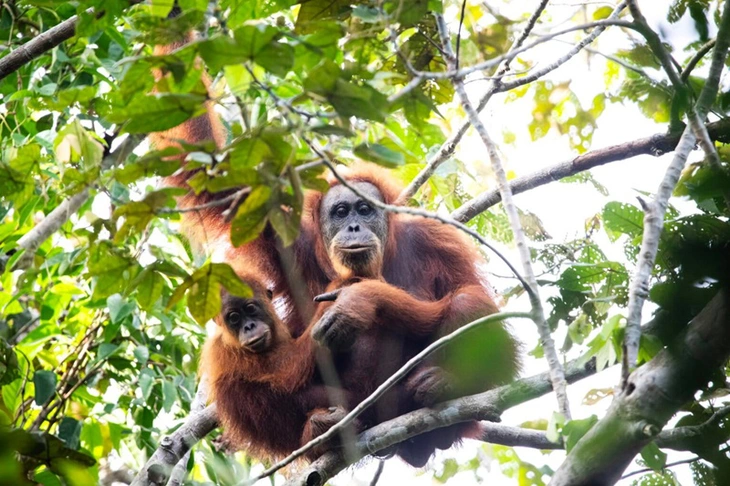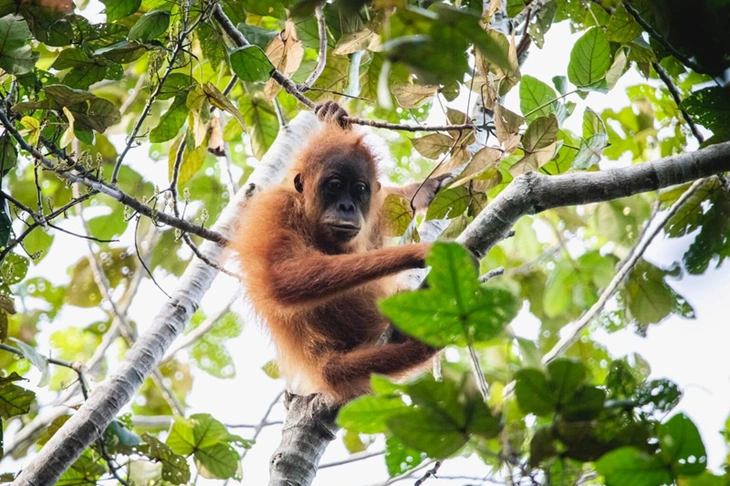
A mother and baby orangutan were discovered in the Lumut Maju peat swamp, Indonesia - Photo: MONGABAY
According to Mongabay on October 17, Indonesian researchers have just discovered the existence of a population of Tapanuli orangutans ( Pongo tapanuliensis ) - one of the rarest primates in the world - in the Lumut Maju peat swamp, 32km from the area once thought to be the only habitat of this species in Batang Toru forest, North Sumatra province.
In late September 2025, a research team from the Sumatran Orangutan Conservation Organization (YOSL-OIC) walked for hours through dense vegetation to observe and film a mother and her calf in secondary forest near Lumut Maju village in Central Tapanuli district.
This is the first recorded appearance of the Tapanuli orangutan in this Indian Ocean border area.
Previously, surveys from 2022 to 2024 in the peat swamp area discovered more than 20 new orangutan nests and fecal samples, but no orangutans. After DNA analysis, researchers confirmed that they belonged to the Tapanuli orangutan species.
The first direct encounter between the research team and the Tapanuli orangutan at Lumut Maju was in October 2024.
This discovery extends the known distribution range of this species, which was previously thought to be limited to the Batang Toru region.
According to YOSL-OIC, the discovery provides important information for conservation strategies, highlighting the importance of peat swamp forests as potential habitats for this critically endangered orangutan species.
The Tapanuli orangutan was announced as a new species in 2017, but has the oldest evolutionary history of all orangutans, separated from a common ancestor 3.4 million years ago. Its outstanding features are flat cheeks, curly hair, and a preference for eating rare plants.

Immature orangutan discovered in Lumut Maju peat swamp, Indonesia - Photo: MONGABAY
There are only about 800 individuals left in the wild, making the Tapanuli orangutan the world’s most endangered large primate according to the IUCN Red List. The new population at Lumut Maju, though likely only a few dozen individuals, opens up the opportunity to better understand the species’ range and genetic makeup.
However, the habitat at Lumut Maju is not within an Indonesian protected area and is being rapidly reduced due to land reclamation and palm oil plantation expansion.
By 2025, less than 1,000 hectares of forest will remain, seriously threatening the orangutan's habitat. Experts say connecting or relocating individuals to Batang Toru - a larger, more protected forest - could be a long-term solution to maintain the species' genetic diversity.
According to researcher Wanda Kuswanda, who works at the Indonesian National Research & Innovation Agency (BRIN), successful conservation of the Tapanuli orangutan requires “sustainable coexistence” between humans and the primate – where survival and livelihood needs need to be balanced within the same ecosystem.
Source: https://tuoitre.vn/phat-hien-moi-ve-loai-linh-truong-hiem-bac-nhat-the-gioi-20251017210239555.htm



![[Photo] Immerse yourself in the colorful musical world of “Secret Garden Live in Vietnam”](https://vphoto.vietnam.vn/thumb/1200x675/vietnam/resource/IMAGE/2025/10/18/1760805978427_ndo_br_thiet-ke-chua-co-ten-41-png.webp)
![[Photo] Closing ceremony of the 18th Congress of Hanoi Party Committee](https://vphoto.vietnam.vn/thumb/1200x675/vietnam/resource/IMAGE/2025/10/17/1760704850107_ndo_br_1-jpg.webp)
![[Photo] Collecting waste, sowing green seeds](https://vphoto.vietnam.vn/thumb/1200x675/vietnam/resource/IMAGE/2025/10/18/1760786475497_ndo_br_1-jpg.webp)
![[Photo] General Secretary To Lam attends the 95th Anniversary of the Party Central Office's Traditional Day](https://vphoto.vietnam.vn/thumb/1200x675/vietnam/resource/IMAGE/2025/10/18/1760784671836_a1-bnd-4476-1940-jpg.webp)

































































































Comment (0)